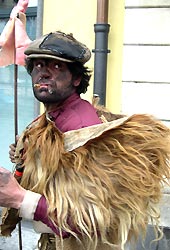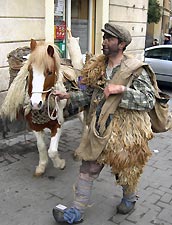You are in: Home–› The traditions | THE ANNUNCIATED FEAST THE SEPULCHERS THE HOLY FRIDAY TYPICAL DISHES TYPICAL SWEETS |
The traditions, the uses and rituals
Many, some very old, the traditions, the uses, the rituals that the brontese people hand down from generation to generation; tied to the farming small world, to the seasons following one another, to the hard work on the fields or to religious recurrence.
For centuries the life of our small city has gone on to the rhythm of seasonal cycles, with keeping in mind in every period of the year, the correspondent phases of rural work: these were dictating the time's rhythm and through these the days, the seasons, the weather assumed a particular significance.
|

| The so called "industrial era" has not altogether broken yet the ancient seasonal rhythm, to put in its place the mathematic clock time but many traditions have gradually lost their original meaning.
At the end of the farming epoch and the prevailing of technological society many habits, some festivities or particular customs rest nowadays only in the memory of our elders; others, as the years go by and in our present frenetic life, are gradually disappearing, substituted by modern rituals. The majority of those that arrived to us, regard principally the Church holidays, maybe just for the character profoundly religious of the people of Bronte (Christmas, the rituals of the Holy Week, the pretty small altars prepared in the small streets of Bronte during the Corpus Domini, the Ascension Day, the Annunciation Feast). Of some our ancient tradition we want, in these pages, remember them and try to present some aspects.
| The "Virginelli" The traditional feast to the "virginelli" is very old and is tied to the hospitality and to the profound religiosity of our people. The 19th of March, holiday of San Giuseppe, many families, even nowadays, prepare the banquet to the "virginelli" (originally poor boys and girls of town, now only relations and friends children of the neighborhood). The number of the invited boys varies depending on the votive offering expressed by the host or the economic possibilities of the same. Typical traditional banquet foods are a first course of pasta with chickpeas and a second of fried salt cod and fennel salad. At the end are given oranges and some bread to take home (a particular small loaf of bread, marked on top with a cross). Everything is blessed , beforehand, by a priest in front of a small altar prepared in the house for the occasion, and then is distributed to the guests and, in part, to relatives and neighbors who helped to prepare the feast. The gesture of the bread gift, a sacred food, has for this people an important protective function of solidarity, reciprocal affectivity and one of the many ways to release themselves from vows. |
| Thursday "Laddaroru"  A Bronte carnival mask that originates from a typical tradition that has disappeared and is almost completely forgotten and is only occasionally revived for tourist or folkloristic purposes. A Bronte carnival mask that originates from a typical tradition that has disappeared and is almost completely forgotten and is only occasionally revived for tourist or folkloristic purposes.
Until a few decades ago, on the Thursday before the Carnival celebrations - Fat Thursday or, in Bronte tradition, "gioveddì laddaròru" (the previous one is instead dedicated to macaroni and called "gioveddì maccarrunàru") - some boys, usually very poor, dressed in rags and with sheepskin on their shoulders and with their faces blackened by coal, wandered around the streets of the town with a long spit in their hands ('u spitu).  They knocked on doors from house to house, followed by a queue of other noisy boys. The aim was to collect something to eat given to them by skewering pieces of meat, bacon, cheese, bread and other food on the spit. They knocked on doors from house to house, followed by a queue of other noisy boys. The aim was to collect something to eat given to them by skewering pieces of meat, bacon, cheese, bread and other food on the spit.
A veiled threat was shouted to whoever opened the door of their house with the traditional chant:
- "O mi fa' u laddaròru, o ti zziccu stu cagnòru!"
The term “laddaroro” is synonymous with dirty, since perhaps initially those unfortunates were dressed in rags and had their faces dirty with coal. Probably, they were carbonari who worked on the slopes of Etna.
The «Laddarori» now live again only in some rare re-enactments of the Pro Loco. |
| | | Since the first years of ‘900, at the Corpus Domini eve, the priests used to go in procession, holding in their hands a broom with a cane’s handle. This ancient custom, nowadays completely gone and forgotten, meant that the priests were humbly prepared to sweep the streets where the day after the Eucharistic Host had to pass. |
|
|